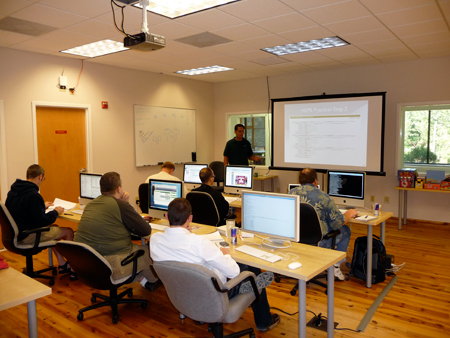I like money. Money buys a certain amount of security, and security buys freedom.
But Gordon Gekko was wrong: greed is not good. Trying to make money for money’s sake is usually the wrong thing to do. Build a product, help your customers, and take care of your employees and the money will come. Shortcuts often lead to heartache.
Take today for example. The Dow Jones Industrial Average had the lowest single point drop in its history, due to the fact that a bunch of people got greedy and for once Congress decided not to write a blank check. And for those of you who think the sky is going to fall if something isn’t done right now, I agree with these guys.
But on to other news that’s more directly related to open source, it looks like Ringside Networks is closing shop.
I really hate it when things like this happen. Now, I’m not worried about Bob Bickel. I’ve met him a couple of times and he’s pretty smart so he’ll be fine. But my guess is that he worked with a lot of cool, smart people who haven’t quite had his level of success. They probably put a lot into their product and now, due to some bad decisions, it seems to be over.
Bob blames it on bad luck (well, the lack of good luck which is the same thing). It sounds a lot like the problems with the current financial markets – ooops, it was just bad luck that the sub-prime mortgages we made to people who couldn’t pay, well, didn’t get paid.
I’m being a bit cruel and I’m definitely oversimplifying, but if you read his description of the failure from my point of view, it does seem a bit like sour grapes.
Although he doesn’t name them, it appears that while Ringside Networks was trying to raise money from VCs, they were approached by Google who wanted to acquire them. He writes “we decided that the larger company would enable us to get our technology to market sooner and with more impact.”
I read that as “w00t! We can cash out early!”.
When Google changed their minds and the acquisition didn’t happen, Bob said they were unable to get any money since “we kind of burned the VCs”.
Bah. You don’t “burn” VCs. VCs are soulless, pure businessmen. The best are unemotional. “You don’t want our money? Fine. See ya”. They could care less about not being able to fund Ringside. If their technology was so good, “the very best VC firms” would have been fighting to fund them.
What they did care about was that Google decided to pass on Ringside. Google is a company known for integrating some of the best technology out there as well as incubating new, small companies, so if Google didn’t want your product, there must have been a reason.
Bob doesn’t tend to work with crap, so my guess is that Ringside probably had a pretty good project going, but that greed got in the way. Bad decisions were made. It wasn’t luck. For instance, they could have taken the best term sheet offer they could and then sold to Google at a later date, but that would have diluted the company considerably. It might have made them less appealing (but then the deal never happened anyway) but they would still be around.
It is real easy for me to sit back and armchair quarterback this story, and like many things I probably have it wrong, but since this purpose of this blog is to provide a reference for others who might want to start an open source business there is one other thing I want to point out.
Bob says, “our development had stalled because of our desires to build stuff aligned with our new direction in the non-evil company.”
Back in the early part of 2007 we were approached by a company that wanted to acquire our company. We were pretty excited, but as things moved along we began to have doubts. I have a very strong idea of what an “open source” company should be, and unfortunately that doesn’t always agree with the guys on Sand Hill Road. Walking away from that deal was one of the hardest things I’ve ever done, but I think one of the best.
During this process OpenNMS development damn near stopped. Thank goodness the community was able to step up and keep things going, because we were worthless. It is very easy to get caught up in the process and to let drop the things that made you attractive in the first place.
So that’s today’s small nugget of wisdom. Stay focused on your product, focused on your customers and focused on your team – no matter what – and you’ll make your own luck.
[Note: Ben had a lot to do with some of the thoughts behind this post]


